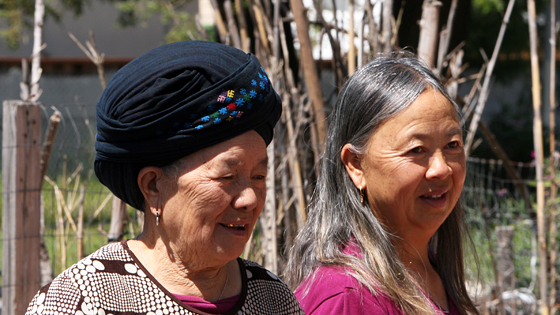The farmers grow many things we're all familiar with: pumpkins, corn, squash and so on. But perhaps the most interesting plants come straight from seed sent by family and friends back in Laos and Thailand.
Tafoo Saechao (it’s a common surname among the Mien) is a counselor for Lao Family, which estimates at least 450-500 Mien seniors in Oakland arrived in the early 1980s: all with little to no English-speaking skills.
Even Tafoo, who serves as our interpreter, struggles to name everything the farmers are growing. “Back in Laos, they grow many kinds [of beans].” Laughing as he points to one variety, he says “It’s a funny name but I don’t know how to say it in English. One kind of bean they call chicken crow’s bean. Jae gai dop. They have many names. And many kinds: long ones, short ones, medium ones.”

Yen Fong with Top Kway. Photo: Nina Egert
You’ve seen Top Kway in Asian markets. Break these long, skinny beans into manageable pieces and you can do anything you’d do with a shorter green bean, like fry them up in oil with hot peppers and/or spices.
In a similar fashion, many traditional herbs work well in any recipe that calls for a mix of herbs like mint and cilantro, whether stir-fried or stewed.

Nai Siew holding herbs. Photo: KQED/Don Clyde
That said, some of the herbs grown at Peralta Hacienda have specific medicinal qualities you’ll want to know about before you throw them in your pot.
Dyear Zwang, for instance, is often cooked with chicken, and served to post-partum women to help stop bleeding and rebuild their iron reserves. Zyeah Awh Myeeah, also cooked with chicken, encourages lactation. Just so you know...
After May Yan Saechao arrived in Alabama (a pit stop on the way to Oakland), she sent a cassette tape to friends in Thailand, asking for some Dyear Zwang to grow here in the U.S. Unclear on the concept, her friends sent her the plants, which did not arrive in good shape. She managed to salvage a few seeds and sent those back. Finally, a package arrived bearing enough seeds for her to establish a local crop for Mien women here in the U.S.

Lai Buah, or wild blue mustard greens. Photo: KQED/Don Clyde
Foo Sina, 76, is particularly fond of his Lai Buah, or wild blue mustard greens. He likes to saute them with garlic, salt, dried red pepper, and soy sauce. You'd think the fresh appeal of farm to table would carry naturally through the generations, but Sina complains his grandchildren are not carrying on the tradition. Instead, they're happy to eat traditional foods that somebody else pulls out of the ground and prepares in the kitchen. “They lazy! They didn’t do anything. Only eat, go to the store, buy there. Very easy spend the money.”
If you’re inclined to be “lazy” and let somebody else do the cooking, you can find Mien dishes at Champa Gardens and Vientan Café, both in Oakland. You'll notice them described as "Asian fusion" and "Vietnamese, Thai," but those in the know say there's somebody Mien in the kitchen.
Recipe: Mey Yan's Num (Pumpkin Blossoms)
Pick 2 quarts worth of pumpkin blossoms. Remove stems and strings. Heat up vegetable oil in a frying pan, toss in blossoms and sprinkle with salt. Cook until tender. Serve!



